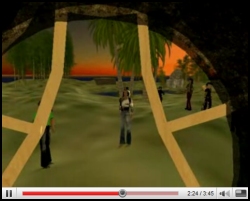Green Architecture Contest Highlights Real World Environmental Issues, Virtual World Copyright Issues
July 8th, 2008 by Kenan Farrell
 An eco-friendly international architecture design competition is being held within Second Life where the grand prize is the real-world construction of the winning green structure. In China. Cool.
An eco-friendly international architecture design competition is being held within Second Life where the grand prize is the real-world construction of the winning green structure. In China. Cool.
The contest is sponsored by architecture website arcspace.com, eco-architecture firm Ecoland-Ecoscape and the International Network for Bamboo and Rattan. Architects, designers and students from around the globe were invited to take part in the competition, which involves the development of an “Eco-friendly Community” to be located in a bamboo forest in Sandao, China, 14 km inland from popular resort destination, Sanya’s Yalong Bay (warm and sunny all year round, Sanya is known as China’s Hawaii). The undeveloped construction site has been precisely recreated in Second Life (SLURL), providing designers unprecedented ability to work directly with the landscape. Every step of virtual progress will be broadcast on YouTube to encourage participation by non-SL residents. The competition is currently entering its second phase, when 12 semi-finalists will be narrowed down to three winners by the jury.
Eco-architect (ecotect?) David Greenberg, of Ecoland-Ecoscape, champions the idea of “sustainable ruralism,” and challenges competitors to develop a community “where people will live, work and visit; an environment which will encourage a wide range of uses, occupied at all times of the day.  The goal should be to stimulate social, technical and cultural progress.” Greenberg’s Second Life avatar explains the vision and rules of the competition in this nifty YouTube video.
The goal should be to stimulate social, technical and cultural progress.” Greenberg’s Second Life avatar explains the vision and rules of the competition in this nifty YouTube video.
The competition is taking place in two phases. At the conclusion of Phase I on June 1, the jury began the selection of twelve designs to continue to Phase II of the competition. All presentations were filmed and will be shown at YouTube, arcspace’s location in SL, and www.arcspace.com, to invite the public to comment and vote for an additional three winners who will continue to Phase II. In Phase II, the jury will select the final three winners who will travel to the actual construction site. The grand winner will be invited to assist with the construction in China. (Again…cool.)
The structure must take into account Sandao’s tropical climate and, in keeping with the eco-mission, promote the use of hybrid materials, with a minimum of 25% bamboo. Ultimately, the project is meant to demonstrate the important role of bamboo and rattan from plantations and sustainably managed forests in providing economically viable environmental services.
A few comments on copyright issues and the project generally follow.
Copyright
The project’s emphasis on interaction between international competitors highlights the power of virtual worlds for providing a global workspace as opposed to just a global forum. Certain legal issues spring to mind. As VB noted regarding 3-D Fabrication, IP law in particular can be turned on its head when virtual world objects start being copied into the real world.
Since the Architectural Works Copyright Protection Act of 1990, “architectural works” have been subject to copyright protection. The copyright law defines “architectural work” as “the design of a building embodied in any tangible medium of expression, including a building, architectural plans, or drawings.” 17 USC 101. Presumably, this includes a structure created in Second Life. While Second Life does grant ownership of intellectual property, the Terms of Service and End User License Agreements for many virtual worlds don’t grant ownership of copyrights to the user/creator, meaning that rights in architectural works in those spaces could be lost.
Commentary
It is important to always keep in mind that these techniques and applications are still in their very early stages. As processing speeds and graphics continue to improve, and other innovations not even conceived yet begin to appear, virtual worlds will grow to become even more powerful and effective tools. Once architects, developers and community planners embrace virtual worlds as viable platforms for undertaking large-scale, environmental and social-friendly projects, the whole world will enjoy the benefits.
Interesting and cool sidenote: Sanya, location of Yalong Bay, is also the site of a new Chinese underground nuclear submarine base. As of May 2008, tunnels were being built into hillsides which could be capable of hiding up to 20 nuclear submarines from spy satellites.
Related Posts on Virtually Blind
- Madrid’s Campus de la Justicia Building Mysterious Second Life Presence: "Madrid's Campus de la Justicia is under construction in Second Life,..." (3 comments)
- Key Second Life Trademark Applications to Be Published for Opposition Over Next Month: "Several key trademark applications for Second Life creator Linden Lab..." (0 comments)
- Virtual World Screenshots Raise Copyright Questions: "There's an interesting post over at Not Possible In Real Life asking..." (22 comments)
2 Responses to “Green Architecture Contest Highlights Real World Environmental Issues, Virtual World Copyright Issues”
Leave a Reply
Notes on Comments: Your first comment must be manually approved, but after it is you'll be able to post freely with the same name and email. You can use some HTML (<a> <b> <i> <blockquote> etc.) but know that VB's spam blocker holds posts with five or more <a> links. VB supports gravatars. Got a gravatar? Use the associated email and it'll show with your comment. Need one? Set it up for free here.



Big thanks to Kenan, who usually covers Asian MMO games and virtual worlds for VB, for finding this and writing it up. Look for another post from Kenan in the next day or so on the coolest, scariest technology yet for controlling an avatar.
If you’re a regular reader who is interested in writing a guest piece or becoming a regular contributor for VB, drop me a line.
What a great idea!
Can we get one for the green contractors out there?